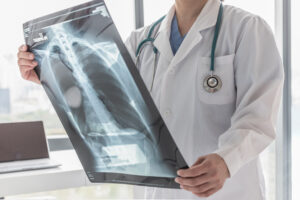
When you suffer a laceration, platelets in your blood stick together to slow or stop the bleeding. But when your blood chemistry and activity levels change due to an injury, a blood clot can also form.
When a clot gets stuck in the deep veins of your legs, hips, or arms, it can slow the circulation of your blood, leading to pain and swelling. In a worst-case situation, a clot can break off and travel toward your heart, causing permanent damage to your veins and lungs.
Table of Contents
What Is the Function of Your Circulatory System?

Every cell in your body requires oxygen for cell metabolism, and red blood cells, in particular, attach to oxygen molecules in the lungs. The heart then pulls oxygenated blood from the lungs and pumps it all over your body through your arteries. As the red cells pass through your body, they drop off oxygen and pick up carbon dioxide.
The oxygen-depleted red cells travel back to the heart through the veins. At that point, the heart pushes the cells into the lungs, where the carbon dioxide molecule gets replaced by another oxygen molecule. The entire process then repeats.
Your arteries and veins differ in structure. Arteries sit on the high-pressure side of your circulatory system. The heart can easily push oxygenated blood up to your head and down to your feet.
Veins, in contrast, sit on the low-pressure side of your circulatory system. The heart can suck blood by creating a slight vacuum as it beats. But between beats, the system does not always maintain enough vacuum to prevent the blood from flowing backward under the influence of gravity.
To hold the blood between beats, the deep veins in your legs, such as the femoral and popliteal veins, include several valves that close between beats. The closed valve prevents the blood from flowing backward when the pressure in the veins drops.
What Causes Deep Vein Thrombosis?
Deep vein thrombosis happens when a blood clot develops in a deep vein in your legs, hips, or arms. The blood flow in these locations slows, allowing blood clots to form under certain circumstances, such as:
Reduced Activity
Movement increases your blood pressure. Increased blood pressure pushes your blood with enough force that it does not pool and form clots. When you cannot move, your blood pressure decreases. And when you reduce your activity after an injury, your blood slows enough to clot.
For example, if you break your hip in a slip and fall accident, you might be immobile for up to eight weeks. During this time, you will have an elevated risk of developing blood clots.
Pressure
Pressure on your legs or hips can pinch your deep veins, with blood potentially collecting behind the pinch point. And wherever blood collects, a clot can develop.
Suppose that you injure your back in a car accident. Your doctor may prescribe bed rest until your back heals. Though you did not injure your lower limbs, you can develop blood clots in the leg and hip veins while lying in bed. Your mattress creates pressure points on your lower limbs that slow your blood and cause clots.
Bone Fracture
The body heals bone fractures by forming a clot over the broken ends of the bone. If a piece of the clot breaks off, it can lodge in the veins where the pressure drops.
Reduced activity and pressure from a cast or brace can contribute to clot formation in the deep veins. Notably, you can develop deep vein thrombosis in your legs regardless of the location of the fracture.
Surgery
When you undergo surgery, your body releases clotting factors into your blood. These chemicals help save your life by stopping any bleeding the surgery caused. But these same clotting factors can also cause your blood to coagulate in your deep veins.
These clots are particularly likely to form when combined with the other two conditions. Your activity level drops after surgery, and prolonged bed rest can produce pressure points. Doctors counteract the formation of clots by prescribing pneumatic compression devices or compression socks to squeeze your feet and lower legs.
What Are Some Symptoms of Deep Vein Thrombosis?
Clots in your deep veins will slow or stop your blood circulation.
As a result, blood will accumulate behind the clot, producing symptoms such as:
- Pain or cramping
- Swelling
- Discoloration
- Fever in the swollen area
Deep vein thrombosis can also happen without any symptoms or with only mild discomfort that might mislead you into believing you have a bruise or sore muscle.
What Are Potential Complications from Deep Vein Thrombosis?
Deep vein thrombosis can cause long-term complications such as:
Vein Damage
Clots can form behind the valves in your deep veins, and the pressure of a clot can damage a valve. Clots also damage the valves in your veins as they travel toward the heart, scraping and getting caught in the valves along the way.
Pulmonary Embolism
A pulmonary embolism occurs when a clot breaks off and lodges in an artery that connects the heart to the lungs. The clot decreases your ability to oxygenate your blood because blood cannot travel through the blocked artery.
As a result, you could experience chest pain and shortness of breath. If you do not receive emergency treatment, you could suffer permanent lung damage or even die from a lack of oxygen.
How Can You Get Compensation for Deep Vein Thrombosis?
You can pursue personal injury compensation when someone’s intentional or negligent actions cause your deep vein thrombosis. This holds true even if your deep vein thrombosis was not a direct result of your accident.
For example, suppose that you experienced deep vein thrombosis while recovering from a car accident. If someone else’s negligence led to your car accident, they bear the liability for all your medical expenses, including those you incurred due to deep vein thrombosis.
To prove causation, you need to show cause-in-fact and proximate cause. Cause-in-fact means that the other party’s negligence fell in the logical sequence of events that resulted in your deep vein thrombosis. Proximate cause means the negligent act was the type that could foreseeably injure someone.
You do not need to show that the at-fault party foresaw your exact injury. Instead, you need to show that any type of injury was a natural and foreseeable result of the negligent action. To discuss your deep vein thrombosis and the compensation you can seek for it, contact Shaked Law Personal Injury Lawyers at (305) 937-0191 for a free consultation.
